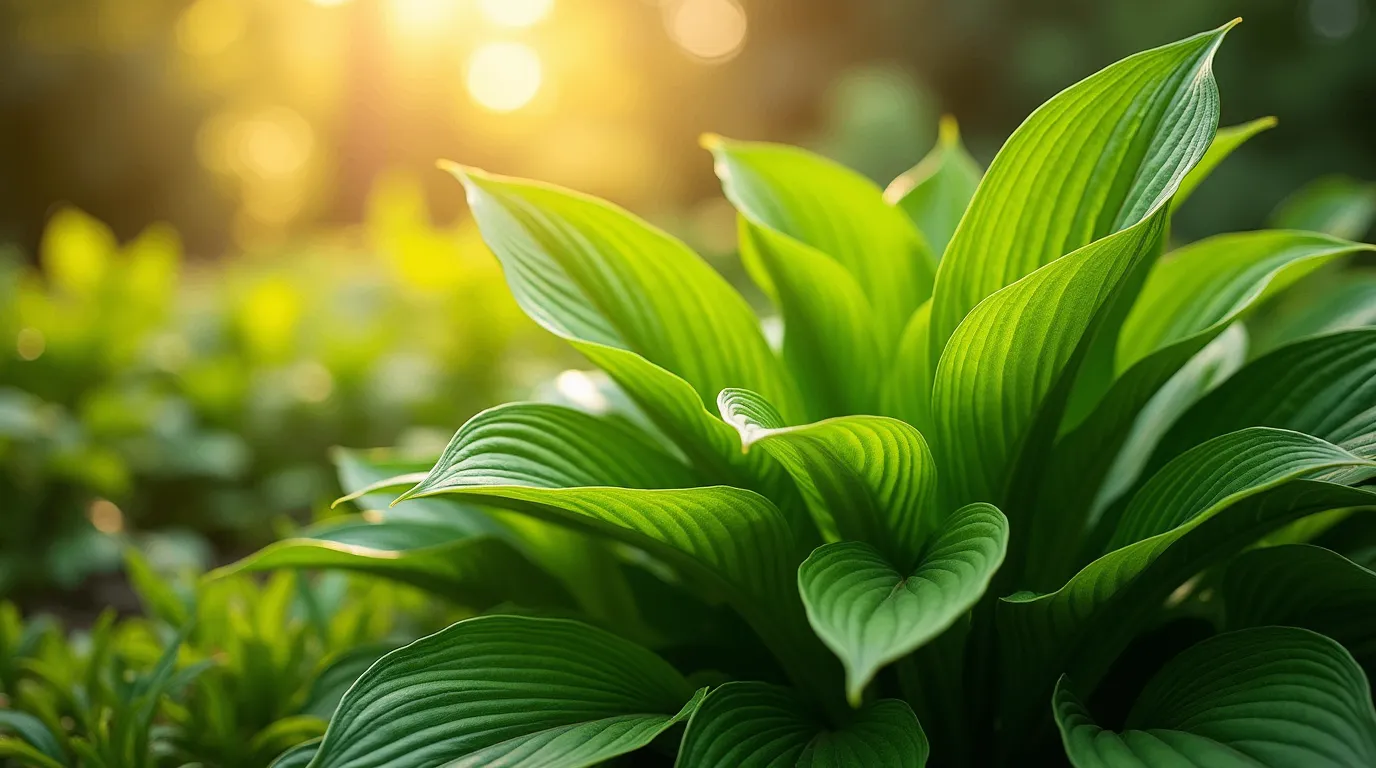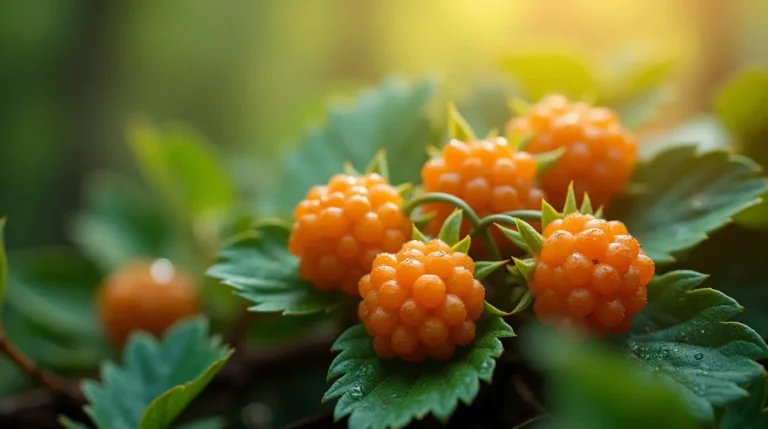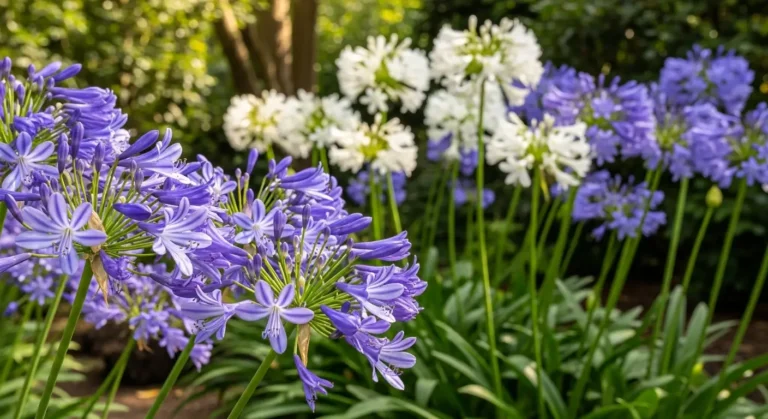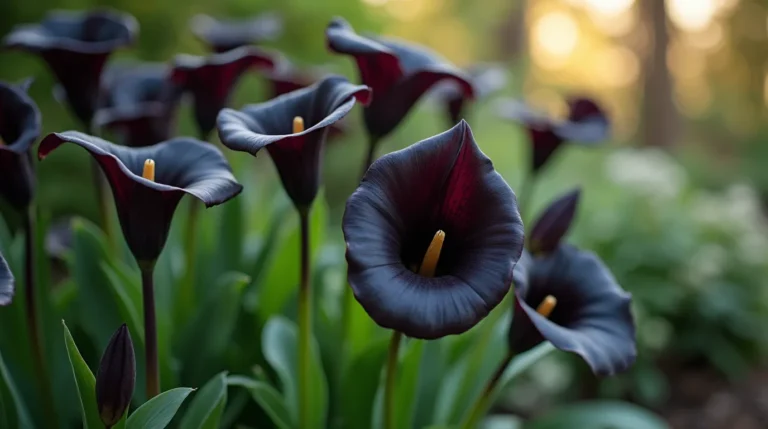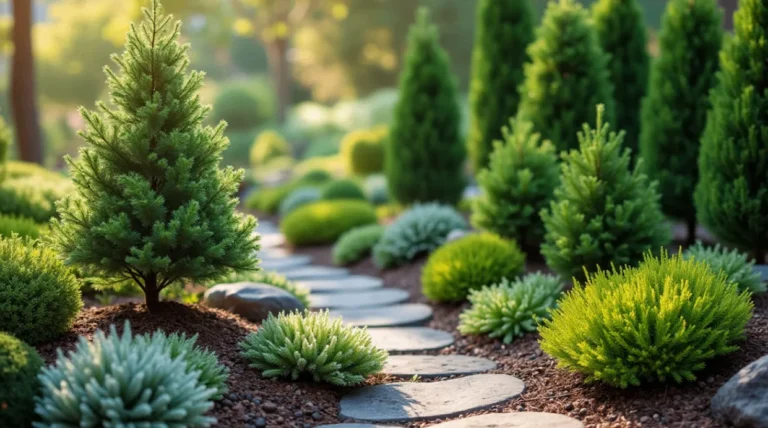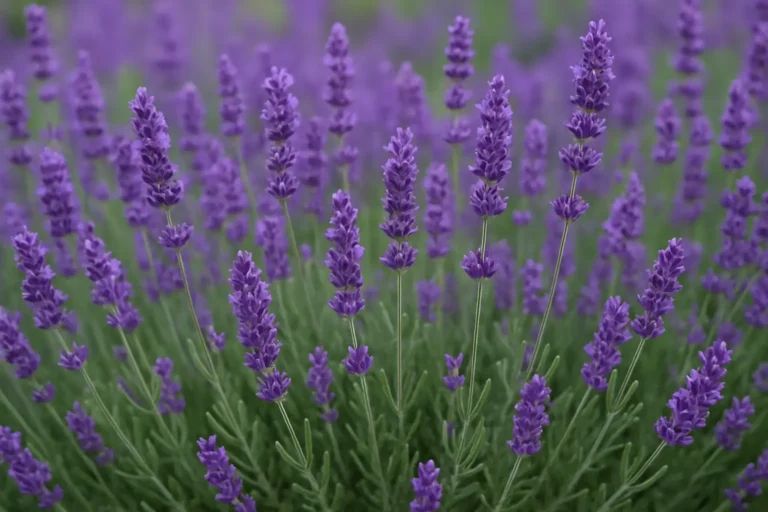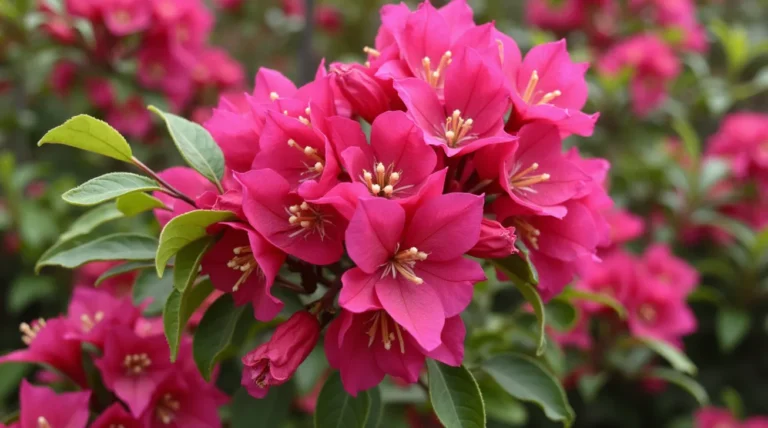Hostas Care: How To Grow Lush, Healthy Foliage
Hostas are a favorite among gardeners in the United States. They are known for their beautiful, lush foliage. To grow healthy hostas, it’s important to know their specific needs. Proper care is key to keeping these plants looking their best.
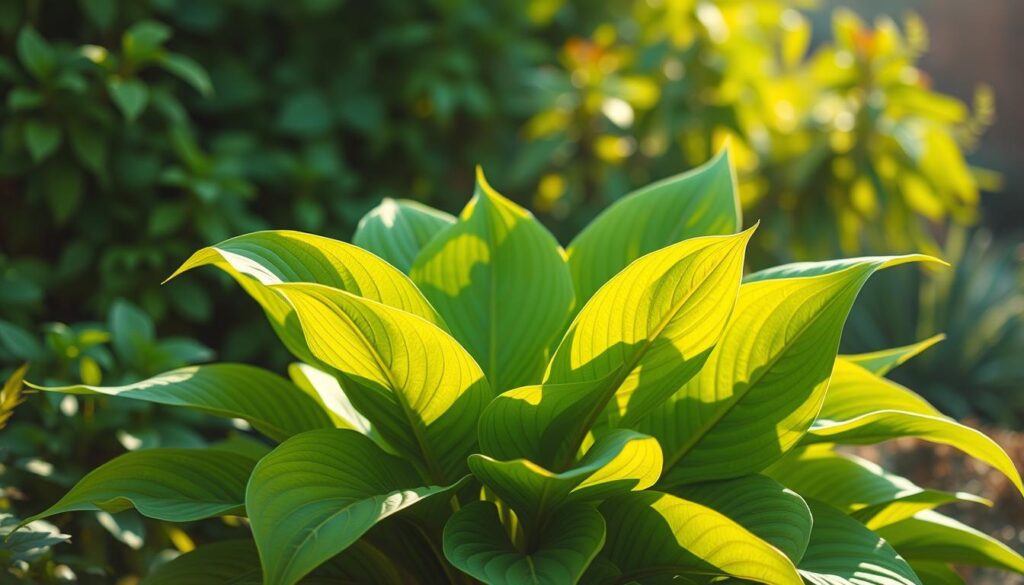
By following a few basic gardening principles, you can help your hostas thrive. Understanding what hostas need is the first step to a beautiful garden. Hostas are versatile and can add texture and color to any garden, making them perfect for gardeners of all levels.
Key Takeaways
- Hostas are a popular choice for gardeners in the United States
- Proper care is crucial to maintaining the health and beauty of hostas
- Understanding the specific needs of the hostas plant is essential
- Basic gardening principles can help hostas thrive
- Hostas are a versatile plant that can add texture and color to any garden
- Proper care and techniques can help create a stunning garden featuring hostas
Understanding Hostas: The Perfect Shade Garden Plant
Hostas are a favorite for shade gardens. They are easy to care for and come in many sizes, shapes, and colors. When picking the right hostas plant for your garden, consider the type. Different hostas have different needs and looks.
The ‘Blue Mouse’ and ‘Gold Standard’ are common hostas. They have bright colors and do well in shade. In nature, hostas grow in moist, wooded spots with dappled sunlight.
Different Types of Hostas
- Blue Mouse: A compact, blue-leaved variety that is perfect for small gardens.
- Gold Standard: A larger, gold-leaved variety that is known for its vibrant color and ability to tolerate more sun.
Natural Habitat and Growth Patterns
In the wild, hostas prefer rich, moist soil and partial shade. They often grow near streams or in woods. This environment keeps the soil moist and the air cool and humid.
Benefits of Growing Hostas
There are many reasons to grow hostas. They are low-maintenance and can thrive in various conditions. Plus, they add color and texture to shade gardens.
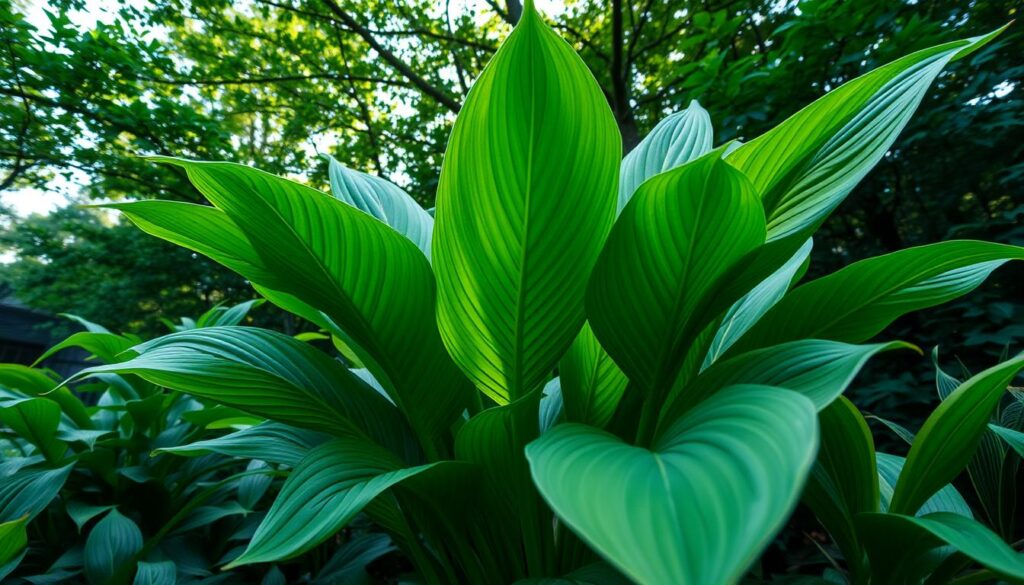
Selecting the Ideal Location for Your Hostas
Choosing the right spot for hostas is key to their health. They need shade, good soil, and the right amount of moisture. Hostas love partial to full shade, perfect for spots with little sunlight.
When picking a spot for your hostas, keep these points in mind:
- Shade: Hostas love shade, especially in hot weather.
- Soil: They prefer soil that drains well and has a pH of 6.1 to 7.0.
- Moisture: Hostas need steady moisture but not soggy soil.
By thinking about these factors, you can make a great spot for your hostas. Remember, hostas are flexible but need some special care. With the right spot and care, your hostas will be happy and healthy.
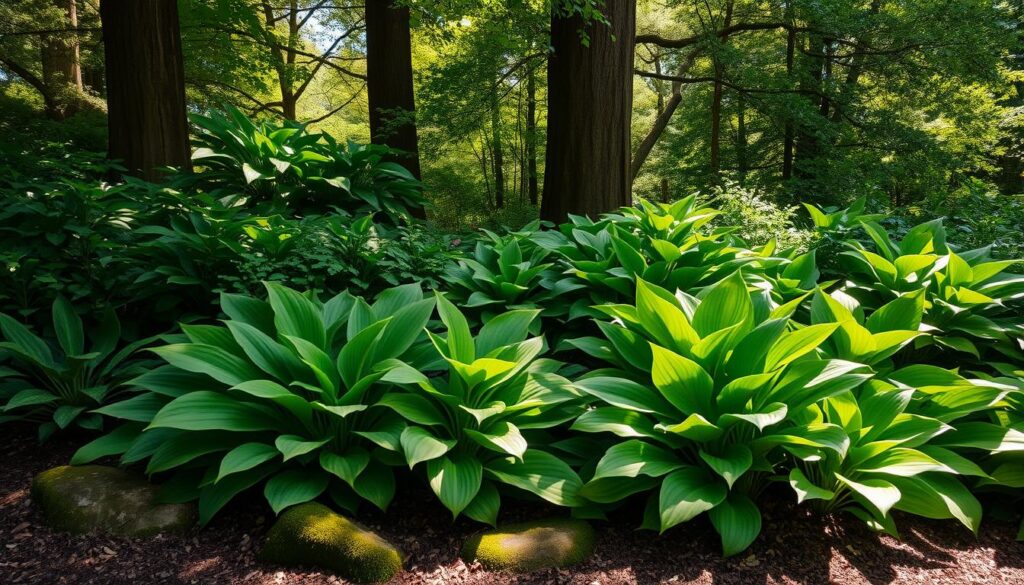
Take time to check your garden’s conditions. Pick a spot that fits your hostas needs. With the right care, your hostas will give you beautiful leaves and flowers.
By selecting the right location for your hostas, you’ll be well on your way to growing a thriving and healthy plant.
Soil Requirements and Preparation
Soil is key for growing healthy hostas plant. To help your hostas grow well, you need the right soil. The best soil for hostas is rich in organic matter and has a pH between 6.0 and 7.0.
To get this, add compost or well-rotted manure to the soil. This improves its structure and fertility. Also, make sure the soil drains well, as hostas don’t like wet feet. Adding peat moss or perlite can help with drainage.
Optimal Soil pH Levels
The best pH for hostas is slightly acidic to neutral. A pH between 6.0 and 7.0 is perfect for nutrient uptake. If your soil is too acidic or alkaline, adjust it with lime or sulfur.
Soil Amendment Tips
Soil amendments can greatly benefit your hostas plant. Here are some tips:
- Use compost or well-rotted manure to boost fertility.
- Mix in peat moss or perlite for better drainage.
- Apply a balanced fertilizer for healthy growth.
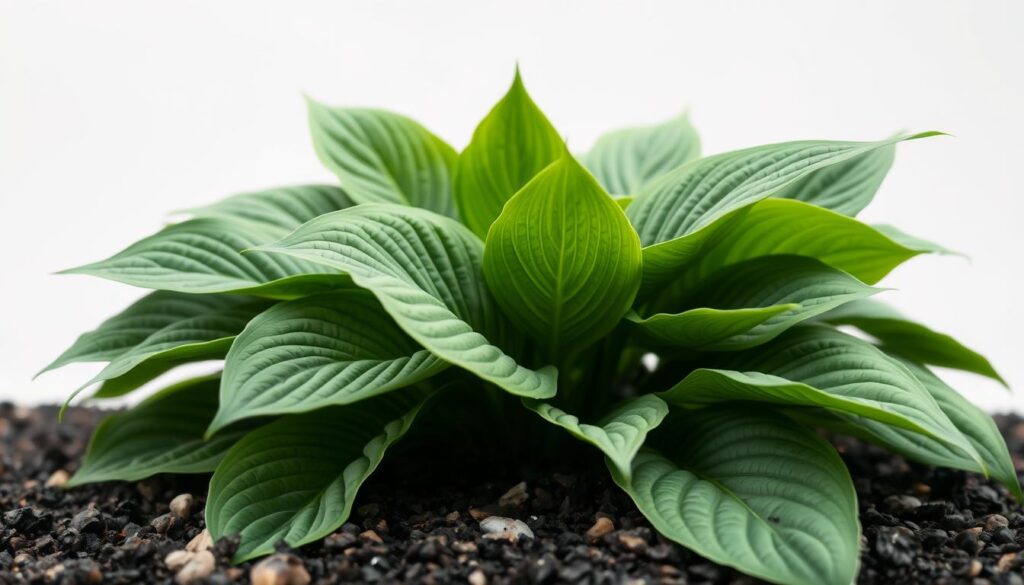
Drainage Considerations
Good drainage is crucial for your hostas. Avoid waterlogged soil to prevent root rot. Improve drainage by adding organic matter or installing a French drain.
| Soil Type | pH Level | Drainage |
|---|---|---|
| Clay | 6.0-7.0 | Poor |
| Sandy | 6.0-7.0 | Good |
| Loam | 6.0-7.0 | Excellent |
Planting Techniques for Healthy Growth
When planting hostas, using the right techniques is key to their growth. To help your hostas grow well, here are some tips:
- Choose a location with the right amount of shade, as hostas prefer partial to full shade.
- Plant hostas at the right depth, making sure the crown is level with the soil surface.
- Space hostas correctly, leaving about 12-18 inches between each plant to allow for proper growth.
By following these guidelines, you can ensure your hostas receive the best possible start. Here’s a summary of the key points to keep in mind:
| Planting Tip | Description |
|---|---|
| Location | Partial to full shade |
| Depth | Crown level with soil surface |
| Spacing | 12-18 inches between plants |
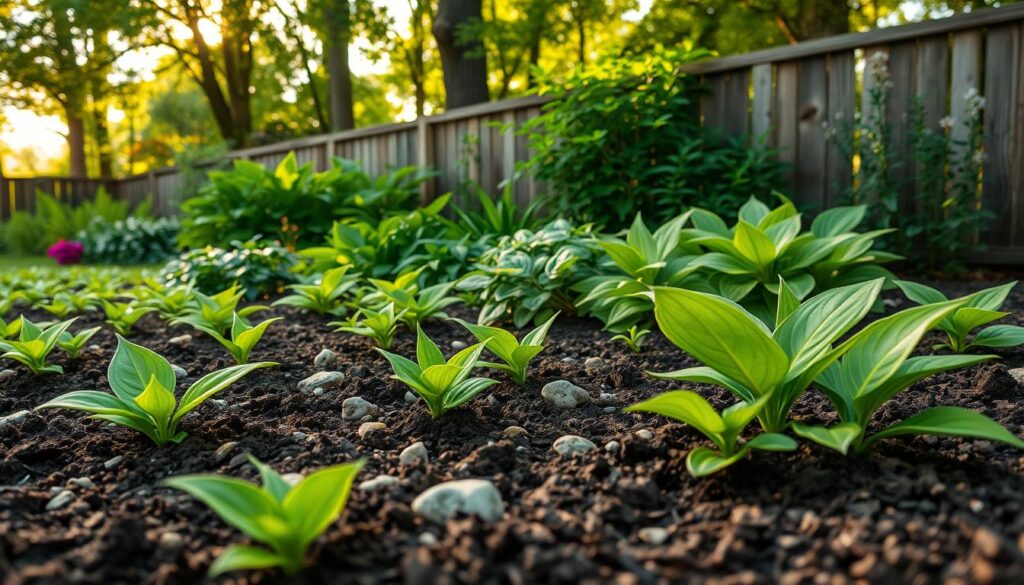
With these tips in mind, you’ll be well on your way to growing healthy and thriving hostas. Remember to plant at the right time, typically in the spring or fall, and water regularly to keep the soil moist.
Essential Watering Guidelines
Watering is key to hostas plant care. They need consistent moisture to grow well. But, too much water can harm them. Knowing their watering needs is crucial.
To water hostas right, aim for a balance. The soil should be moist but not too wet. How often you water depends on the weather, soil, and season.
Watering Frequency
Water hostas when the top inch of soil feels dry. This means watering every 2-3 days in summer. In spring and fall, you can water less often.
Signs of Over and Under-Watering
Knowing the signs of too much or too little water is important. Too much water can turn leaves yellow and cause stems to droop. Too little water makes leaves wilt and grow poorly.
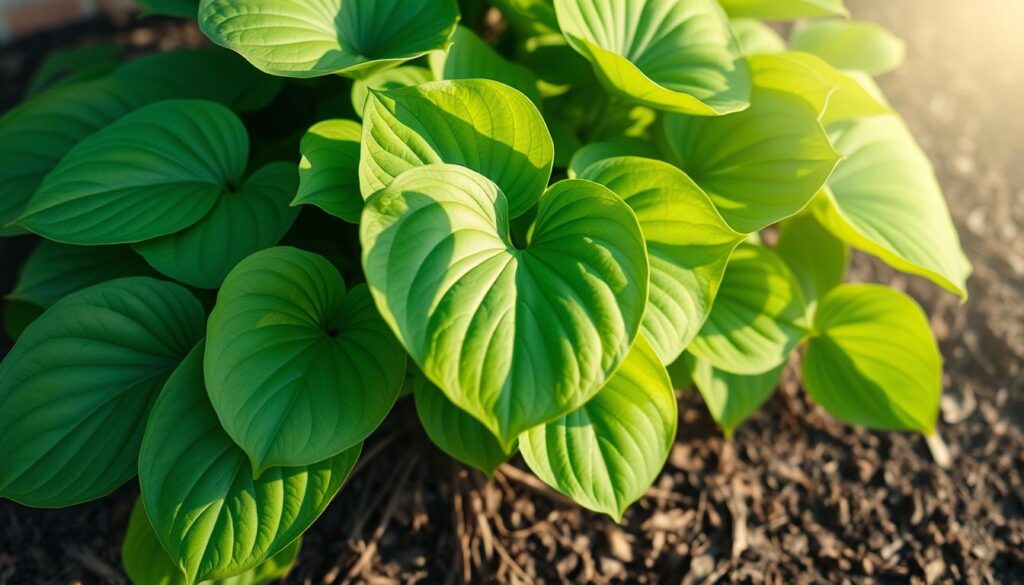
Irrigation Methods
There are many ways to water hostas. Soaker hoses, drip irrigation, and sprinkler systems are good options. Soaker hoses and drip irrigation get water straight to the roots, saving water.
By following these watering tips, your hostas will get the moisture they need. Keep an eye on how they react to watering. Adjust your schedule to give them the best care.
| Watering Method | Benefits |
|---|---|
| Soaker Hoses | Delivers water directly to the roots, reducing evaporation and runoff |
| Drip Irrigation | Conserves water, reduces soil erosion, and promotes healthy root growth |
| Sprinkler Systems | Covers large areas, easy to install, and can be automated |
Fertilizing Your Hostas for Maximum Growth
To help your hostas grow well and look great, fertilizing is key. It’s important to pick the right fertilizer and use it at the right time. Hostas need a balanced diet to do well.
Some important things to think about when fertilizing hostas include:
- Using a balanced, water-soluble fertilizer
- Applying fertilizer during the growing season, typically from spring to fall
- Avoiding over-fertilization, which can damage the plants
For the best results, use a fertilizer made for hostas or shade plants. These fertilizers have nitrogen, phosphorus, and potassium. It’s also important to follow the manufacturer’s instructions for application rates and timing.
Here’s a simple table to help you choose the best fertilizer for your hostas:
| Fertilizer Type | Nitrogen (N) | Phosphorus (P) | Potassium (K) |
|---|---|---|---|
| Balanced Fertilizer | 10% | 10% | 10% |
| Shade Plant Fertilizer | 15% | 5% | 10% |
By following these tips and picking the right fertilizer, you can help your hostas grow strong and look beautiful. Always follow the instructions and avoid over-fertilizing to keep your plants healthy.
Seasonal Care and Maintenance
As a hostas plant owner, it’s key to give seasonal care and maintenance. This ensures your hostas stay healthy and live long. Each season brings different needs for your hostas.
In spring, clean up dead leaves and mulch around your hostas. This keeps moisture in and weeds out. As it gets warmer, your hostas will grow. Make sure the soil stays moist.
Spring Care Tips
- Remove dead foliage and debris from the previous season
- Apply a layer of mulch around the base of the hostas plant
- Water regularly to keep the soil consistently moist
In summer, give your hostas enough shade and water. The hot sun can burn their leaves. So, provide shade, especially when the sun is strongest.
Summer Maintenance
To keep your hostas healthy in summer, do the following:
- Provide adequate shade, especially during peak sun hours
- Water regularly to keep the soil consistently moist
- Fertilize your hostas with a balanced fertilizer to promote healthy growth
As seasons change, prepare your hostas for fall and winter. Cut back foliage and mulch to protect roots from harsh weather.
Fall Preparation
To get your hostas ready for fall and winter, follow these steps:
- Cut back the foliage to about 3-4 inches from the ground
- Apply a layer of mulch around the base of the hostas plant to protect the roots
By following these seasonal care tips, you’ll keep your hostas healthy all year.
Managing Common Pests and Diseases
Hostas are tough plants, but they can still get pests and diseases. Knowing the common problems helps keep them healthy. Pests like slugs, snails, and aphids can harm the leaves and stems, making the plant weak.
To fight these pests, try using neem oil or insecticidal soap. Also, remove any sick or damaged leaves to stop disease spread. Regular checks on your hostas can help you spot problems early, making treatment easier.
Hostas can also get diseases like root rot, leaf spot, and powdery mildew. These often come from too much water, bad drainage, or too much humidity. Plant your hostas in good soil and water them right. Fungicides can help if a plant gets sick.
Knowing about pests and diseases helps you prevent and manage them. With the right care, your hostas will grow strong and add beauty to your garden.
Regular maintenance and inspection are key to keeping your hostas healthy and pest-free. By following these tips and being mindful of the common issues that can affect hostas, you can enjoy these beautiful plants for years to come.
Dividing and Propagating Hostas
Dividing and propagating hostas is a great way to share plants or refresh older ones. This method involves splitting the roots of mature hostas, usually every 3-4 years. It’s key to pick healthy plants with lots of leaves for the best results.
Start by watering the hostas well the day before you divide them. This makes the soil softer. Then, dig up the whole plant carefully to avoid harming the roots. After that, separate the roots gently, making sure each piece has at least one “eye” or growing point. This ensures the new plants will grow well.
Division Techniques
- Use a sharp, sterile knife or garden fork to separate the roots, reducing the risk of infection.
- Divide the hostas in the spring or fall, when the weather is cooler, to minimize stress on the plants.
- Replant the divided sections immediately, water well, and provide adequate care to ensure establishment.
After dividing, it’s important to care for the new hostas plants. Water them regularly, fertilize lightly, and mulch around the plants. This helps keep the soil moist and keeps weeds away. By following these steps and using the right division techniques, you can successfully grow your hostas and enjoy them for many years.
Companion Planting with Hostas
Hostas are great for a stunning shade garden. Pairing them with other plants can make your garden even more beautiful. This not only looks good but also helps your garden stay healthy.
Some top picks for plants to go with hostas are astilbe, heuchera, and ferns. These plants grow well together and look good side by side. For example, ferns add a playful touch to hostas’ strong leaves.
Best Plant Combinations
- Astilbe: adds a pop of color with its feathery plumes
- Heuchera: provides a striking contrast with its maple-like leaves
- Ferns: adds a delicate, lacy texture to the garden
When planning your shade garden, think about layering and texture. Mixing plants with different looks and sizes makes your garden interesting. For example, hostas in the front and hydrangeas or rhododendrons in the back add depth.
Design Tips for Shade Gardens
To make a beautiful shade garden with hostas, pick plants that like low light and similar care. This way, you’ll have a garden that shows off hostas’ beauty.
| Plant | Growth Habit | Light Requirements |
|---|---|---|
| Hostas | Clump-forming | Partial to full shade |
| Astilbe | Feathery plumes | Partial shade |
| Heuchera | Maple-like leaves | Partial shade |
Pruning and Grooming Guidelines
Pruning and grooming are key to keeping your hostas plant looking good and healthy. Cutting off dead or damaged leaves stops disease from spreading and helps the plant grow well. Also, trimming flower stalks after they bloom helps the plant focus on growing new leaves and roots.
To prune your hostas plant, start by cutting off any dead or damaged leaves. Use scissors or pruning shears to remove them at the base. Then, cut back any flower stalks that have stopped blooming. This directs the plant’s energy to growing new leaves and roots.
- Remove any dead or damaged leaves to prevent the spread of disease
- Trim back flower stalks after blooming to direct the plant’s energy towards foliage growth
- Divide and replant your hostas plant every 3-4 years to maintain its health and vigor
By following these guidelines, you can keep your hostas plant looking great. It will stay a beautiful and thriving part of your garden.
Troubleshooting Common Growing Problems
When growing hostas, you might face some issues. These can affect their health and look. Knowing the common problems helps you prevent or fix them, so your hostas can thrive.
Common hosta problems include leaf issues, growth problems, and stress from the environment. These can stem from pests, diseases, or bad growing conditions.
Leaf Issues
Leaf problems are common in hostas. They can be due to pests, diseases, or the environment. Some common leaf issues are:
- Leaf scorch: caused by too much sun or heat
- Leaf spot: caused by fungal diseases
- Leaf chew: caused by pests such as slugs or deer
Growth Problems
Growth issues can also affect hostas. They can be due to poor soil, not enough water, or too much shade. Some common growth problems are:
- Slow growth: caused by poor soil quality or inadequate watering
- Weak stems: caused by too much shade or lack of support
Environmental Stress
Environmental stress can also impact hostas. It can be caused by extreme weather, like drought or too much rain. Some common environmental stressors are:
- Drought: caused by lack of rainfall or inadequate watering
- Excessive rain: caused by heavy rainfall or flooding
Understanding common hosta problems helps you prevent or fix them. With the right care, hostas can be a beautiful, easy-to-care-for addition to any garden or landscape.
| Problem | Cause | Solution |
|---|---|---|
| Leaf scorch | Too much sun or heat | Provide shade or use a sunshade |
| Leaf spot | Fungal diseases | Use a fungicide or remove infected leaves |
| Slow growth | Poor soil quality or inadequate watering | Improve soil quality or increase watering |
Container Growing Tips for Hostas
When growing hostas in containers, there are important things to remember. First, pick a container big enough for the hostas plant when it’s fully grown. This size helps prevent the soil from getting too dry or wet. Look for a container that’s at least 12-18 inches deep and 24-36 inches wide.
For the soil, a mix that drains well is key for healthy growth. You can make your own mix with peat moss, vermiculite, and perlite. Or, you can buy a mix made for container gardening. It’s also important to note that hostas like slightly acidic soil, with a pH between 6.0 and 6.5.
Here are some more tips for growing hostas in containers:
- Water regularly, but don’t overdo it to avoid root rot and other issues.
- Fertilize often, using a balanced fertilizer that’s high in phosphorus to help roots grow.
- Give them partial shade to full shade, depending on the hostas plant type.
By following these tips and using the right materials, you can create a stunning container garden with hostas.
| Container Size | Soil Type | Lighting Requirements |
|---|---|---|
| 12-18 inches deep, 24-36 inches wide | Well-draining potting mix | Partial shade to full shade |
Conclusion: Creating Your Perfect Hosta Garden
Caring for hostas is easy and rewarding. This guide has shown you how to pick the best spot and soil. It also taught you how to water and fertilize them right.
Now, you can create your own beautiful hosta garden. It will add beauty, peace, and a bit of nature to your yard.
To grow hostas well, know what they need. Focus on soil, water, and care through the seasons. This way, you’ll enjoy their bright leaves and lovely flowers.
With some effort and the right steps, your garden will become a peaceful place. It will be filled with the beauty of hostas.
FAQ
What are the different types of hostas?
Hostas come in many shapes, sizes, and colors. You can find broad-leaved, narrow-leaved, and variegated types. Some popular ones are ‘Francee’, ‘Halcyon’, and ‘Sum and Substance’.
What are the benefits of growing hostas in the garden?
Hostas are great for shade gardens. They add texture, color, and interest. Plus, they’re easy to care for and grow well in different soils.
What kind of soil do hostas prefer?
Hostas like rich, well-draining soil. The pH should be slightly acidic, between 6.0 and 7.0. Adding compost or peat moss can improve the soil.
How often should I water my hostas?
Keep the soil moist but not too wet. Water about 1 inch per week during the growing season. Adjust based on weather and soil.
What are the signs of over-watering or under-watering hostas?
Over-watering shows as yellowing or wilting leaves. Under-watering makes leaves wilt and become crispy. Check the soil moisture and adjust your watering.
How do I fertilize my hostas for optimal growth?
Use a balanced, slow-release fertilizer like 10-10-10 or 12-12-12. Apply in early spring and mid-summer. Avoid high-nitrogen fertilizers to keep the plant strong.
When is the best time to divide and propagate hostas?
Divide and propagate in early spring or fall. Dig up the clump, divide it, and replant the sections.
What are some common pests and diseases that affect hostas?
Hostas can get pests like slugs, snails, aphids, and nematodes. Diseases include Hosta Virus X and bacterial infections. Use preventive measures and watch your plants closely.
How do I prune and groom my hostas?
Remove dead, damaged, or discolored leaves all season. Cut back foliage in fall to prepare for winter. Regular grooming keeps the plant looking good.
Can I grow hostas in containers?
Yes, hostas do well in containers. Choose the right pot size and use a well-draining mix. Water regularly and provide shade.

